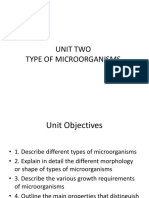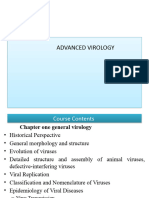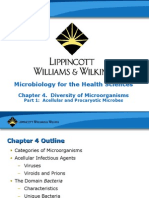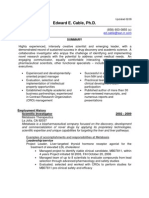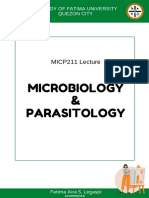0 ratings0% found this document useful (0 votes)
7 viewsCluster 8 Microbiology Lesson 1
Cluster 8 Microbiology Lesson 1
Uploaded by
JudithA brief opening to the world of studying microorganisms is explained.
Copyright:
© All Rights Reserved
Available Formats
Download as PPTX, PDF, TXT or read online from Scribd
Cluster 8 Microbiology Lesson 1
Cluster 8 Microbiology Lesson 1
Uploaded by
Judith0 ratings0% found this document useful (0 votes)
7 views24 pagesA brief opening to the world of studying microorganisms is explained.
Original Title
Cluster 8 Microbiology Lesson 1
Copyright
© © All Rights Reserved
Available Formats
PPTX, PDF, TXT or read online from Scribd
Share this document
Did you find this document useful?
Is this content inappropriate?
A brief opening to the world of studying microorganisms is explained.
Copyright:
© All Rights Reserved
Available Formats
Download as PPTX, PDF, TXT or read online from Scribd
Download as pptx, pdf, or txt
0 ratings0% found this document useful (0 votes)
7 views24 pagesCluster 8 Microbiology Lesson 1
Cluster 8 Microbiology Lesson 1
Uploaded by
JudithA brief opening to the world of studying microorganisms is explained.
Copyright:
© All Rights Reserved
Available Formats
Download as PPTX, PDF, TXT or read online from Scribd
Download as pptx, pdf, or txt
You are on page 1of 24
Module Units
• Unit 1 Microbiology 8 hours
• Unit 2 Immunology 10 hours
• COURSE CODE:MIM 1102
• CREDITS : 2 (10 hrs make one credit)
Module Competence
• Designed to enable the learner
• Promote Health
• Prevent illness
• Diagnose
• Manage and rehabilitate pts/clients
Module Outcomes
• By the end of the module, the learner should:
• Apply concepts in microbiology for dx and
mnx of pts suffering from infectious diseases
• Apply principles of immunology in the mnx of
pts & clients
SPECIFIC OBJECTIVES
1. Describe the historical development
of microbiology
2. State the different classifications of
micro-organisms.
3. Describe the structure and other
characteristics of microorganisms.
4. Explain the identification of
microorganisms in the laboratory
5. Exlpain the types of immunity
5. Describe immunological process
6. Describe infection prevention
DEFINITION
• Microbiology is derived from the Greek;
• Micro – small
• Bios – life
• Logia – study
• It is the study of microscopic organisms
either unicellular (single cell),
multicellular or acellular
It encompasses numerous subdisciplines;
• Virology, Mycology, Parasitology and
Bacteriology
Introduction
• Inside your intestines, in the mouth and on your skin
there reside billions of microbial cells(100 times) the
number of cells that make up the human body
• Because microbes are generally hidden from our senses,
an appreciation of microbiology demands imagination
• Advances in microbiology have transformed diagnosis,
prevention, and cure of infection and has improved
human health.
• In developed countries, infections may be considered
insignificant. In developing countries about 10 million
children die each year from infections of diarrhea,
measles, tetanus, diphtheria and whooping cough alone.
Others are TB, cholera, typhoid
Relevance of Microbiology To Nursing
• One MUST have an idea of how infection spreads from one
point to another.
• Understand surfaces most susceptible to infectious
agents(pathogens)
• How to keep instruments aseptic(Free from microbes)
• Helps nurses to recognise S/S of an infection as soon as they
occur.
• How the body reacts to disease or injury
• Basic knowledge in microbiology is prerequisite for
understanding pharmacology. Insulin is obtained from microbial
culture(Recombinant DNA technology – (rDNA )
• Some antibiotics(drugs) are obtained from microorganisms
HISTORY OF MICROBIOLOGY
• Infection and microbiology followed
different development for centuries
• Discipline of microbiology was formally
established in 2nd half of 19th century
• 17century – Leeuwenhoek:
microorganisms seen by microscopy by
using homemade microscope.
• 18century- John Hunter (1728-1793):
demonstrated transmission of syphilis
and gonorrhea
History Contd
• Edward Jenner (1749 -1823); used cowpox to
prevent smallpox. This established concept of
immunization
• John Snow- (1813 -1858) showed that preventing
access to a water source linked to cholera
outbreak terminated new infections
• This was confirmed by Semmelweis (1818-1865):
who showed that physical measures can prevent
the transmission of infection e.g. applying simple
hygiene measures.
• 19c – Pasteur(1822 -1895) and Robert Koch
(1843-1910):played a central role in establishing
microbial causation of infectious disease
History Contd
• Pasteur: microbes are necessary for
fermentation; also developed live
attenuated anthrax vaccine.
• Joseph Lister (1827 -1912) a British
surgeon developed asepsis aimed at
destroying microorganisms responsible for
infection during surgery
• Robert Koch: Established techniques
required to isolate and propagate pure
cultures of specific bacteria: TB, cholera,
Anthrax
Classification of Microorganisms
• Microorganisms exist as unicellular, multicellular or cellular
clusters.
• Microorganisms can be divided into six major types:
• Bacteria
• Viruses
• Fungi
• Protozoa
• Algae
• Archaea
• Helminths(Not classified as microorganisms per se but some
stages in their life cycle are microscopic.
Classification contd
• Bacteria : ubiquitous single celled organism
rod-shaped, spherical ,spiral in shape
Can appear singly, in clusters or in chains
• Lack nuclei and other organised cell structures ,hence referred to as
Prokaryotes
• Reproduce by binary fission
• Current classification of bacteria is based primarily on morphologic and
biochemical characteristics.
-Staining xtics (Gram –positive and Gram negative cocci and rods )
- Ability to grow in presence or absence of oxygen (aerobic vs
anaerobic bacteria
• Viruses: Small obligate intracellular infectious
agents
Do not posses energised membranes ,ribosomes, or metabolic enzymes.
Classification contd
• Viruses Cannot replicate outside living cells, hence
are completely dependent on their host cells.
• Only infect specific cells eg HIV infects CD4 cells
• Genetic material is either DNA or RNA but not both
• A virus can only replicate after its nucleic acid has
entered and subverted the host cell’s biosynthetic
apparatus to produce new viral particles.
• Examples-measles virus,polio,HPV, Hepatitis
A,B,C,D,rhinovirus ,Rhabdovirus
Structure of Bacterium
Simple Structure of a Virus
Classification contd
• Fungi : These are eukaryotic organisms(membrane
bound nucleus and subcellular organelles such as
golgi bodies,mitochondria
Cause superficial skin infections eg athlete
foot(Tinea pedis) , ringworm(Tinea
capitis),candidiasis –oral or vaginal
• Protozoa : Unicellular eukaryotic microbes
• Has four species > i) sporozoa eg plasmodium
• ii)Flagellates eg trypanosoma Gabiense, T
Rhodensie ,giardia lamblia
Classification contd
• iii)Ciliate protozoa eg Paramecium,Balantindium
coli
• iv)Amoeba eg amoeba proteus, entamoeba
histolytica that cause amoebiasis
• Helminths: Mulcellular animal parasites,are not
microorganisms per se but some stages of their
life cycle are microscopic. eg roundworms(Ascaris
lumbricoids), pinworms(Trichuris trichuria),
hookworms(ankylostoma duodenale)
Algae
• Simple non-flowering photosynthetic
organisms.
• Vary from small single-celled to complex
multcellular forms.
• Algae can produce harmful toxins to humans
and animals. eg spyrogyra, kelps ,seaweeds
Archaea
• Microorganisms which are similar to bacteria in size
and simplicity of structure but radically different in
molecular organization. Archaea differ in the fact that
their cell wall does not contain peptidoglycan
General Properties of Microorganisms
• belong to the Protista biologic kingdom.
• include some eukaryotes and prokaryotes, viruses, viroids
•
• EUKARYOTIC CELLS
• contain organelles and a nucleus bounded by a nuclear
membrane.
• Have 80S ribosomes
• contain complex phospholipids and sterols.
• lack a cell wall (plant cells and fungi have a cell wall).
• have relatively long-lived mRNA(messenger RNA)
• Include fungi, protozoa
General Properties Contd
• PROKARYOTIC CELLS
• have no organelles, no membrane-enclosed
nucleus;
• have 70S ribosomes.
• have a cell wall composed of peptidoglycan
• are haploid with a single chromosome.
• have short-lived, unprocessed mRNA.
• Include typical bacteria and atypical bacteria
(mycoplasmas, rickettsia, chlamydiae)
General properties - Contd
• VIRUSES
• are not visible with the light microscope.
Electron microscope is used instead
• are obligate intracellular parasites.
• contain no organelles or biosynthetic
machinery, except for a few enzymes.
• contain either RNA or DNA as genetic
material.
You might also like
- Biology Complete Important Mcqs For Medical Entry Test PreparationDocument24 pagesBiology Complete Important Mcqs For Medical Entry Test Preparationaamir100% (3)
- Introduction To MicrobiologyDocument40 pagesIntroduction To Microbiologymuhammad tayyebNo ratings yet
- Introduction To Microbiology - MD - 2019Document109 pagesIntroduction To Microbiology - MD - 2019Nathnael GebeyehuNo ratings yet
- Introduction To MicrobiologyDocument34 pagesIntroduction To Microbiologytalhagg333 talhagg333No ratings yet
- Microbiology: Nanette Ramilo-Cruz, MD, DPAFPDocument76 pagesMicrobiology: Nanette Ramilo-Cruz, MD, DPAFPSunshine BonoanNo ratings yet
- LMMU MICRO 2010 - Introdution To Microbiology 1Document20 pagesLMMU MICRO 2010 - Introdution To Microbiology 1mctime35No ratings yet
- Introduction To Microbiology: Prasil PradhanDocument19 pagesIntroduction To Microbiology: Prasil PradhanSrijan BhattaraiNo ratings yet
- Introduction To Microbiology.Document53 pagesIntroduction To Microbiology.fawadkhanisb786No ratings yet
- Introduction to MicrobiologyDocument54 pagesIntroduction to Microbiologyreemabassbabiker4No ratings yet
- Introduction in Medical MicrobiologyDocument47 pagesIntroduction in Medical MicrobiologyOld Lake100% (1)
- Fungi & VirusDocument3 pagesFungi & VirusJazz On WattpadNo ratings yet
- Introduction To MicrobiologyDocument37 pagesIntroduction To Microbiologyfarman AliNo ratings yet
- Chapt01 Notes Q PDFDocument13 pagesChapt01 Notes Q PDFamor magtibayNo ratings yet
- 6.MMB 221 Host Microbe Relationship and InteractionsDocument44 pages6.MMB 221 Host Microbe Relationship and Interactionsedeani22.ifechiNo ratings yet
- Pertemuan 1 2015Document42 pagesPertemuan 1 2015Dianta MalauNo ratings yet
- Lecture 18 - Introduction in Medical MicrobiologyDocument42 pagesLecture 18 - Introduction in Medical MicrobiologyAstri Ggamjong Xiao LuNo ratings yet
- Scope of Microbiology 2022Document22 pagesScope of Microbiology 2022Caamir Dek HaybeNo ratings yet
- 1) History and Contributions Unit-I 1Document14 pages1) History and Contributions Unit-I 1Muhammad Kashif RafiqNo ratings yet
- Introduction To Medical Microbiology: DM Sukrama Dept - Microbiology Faculty of Medicine Udayana UniversityDocument67 pagesIntroduction To Medical Microbiology: DM Sukrama Dept - Microbiology Faculty of Medicine Udayana Universityigus6960% (1)
- Microbiology VirusesDocument66 pagesMicrobiology Virusesanticlock81No ratings yet
- 1 Intro To Micro 15okt2021Document100 pages1 Intro To Micro 15okt2021haiqalfariq07No ratings yet
- Chap. 1 Intro To Microbial World Lecture NotesDocument5 pagesChap. 1 Intro To Microbial World Lecture NotesMohamidin MamalapatNo ratings yet
- Introduction To Microbiology 081210 FV 1Document34 pagesIntroduction To Microbiology 081210 FV 1Lyka AldayaNo ratings yet
- Ch1 Introduction To Microbiology P1&P2Document63 pagesCh1 Introduction To Microbiology P1&P2essa sunnaNo ratings yet
- Introduction To Micro - MD - 2023Document112 pagesIntroduction To Micro - MD - 2023Tall tunaNo ratings yet
- Introduction To Microbiology - 240211 - 162412Document24 pagesIntroduction To Microbiology - 240211 - 162412Ahmed YousefNo ratings yet
- Introduction To MicrobiologyDocument35 pagesIntroduction To MicrobiologyMichael Jay MesaNo ratings yet
- Introduction To Microbiology 3Document30 pagesIntroduction To Microbiology 3yazedm869No ratings yet
- Introduction To Medical Microbiology - Medicine 2004Document61 pagesIntroduction To Medical Microbiology - Medicine 2004michot feleguNo ratings yet
- Chapter 2 Basic Microbiology For IPCDocument33 pagesChapter 2 Basic Microbiology For IPCKedir AbdurehmanNo ratings yet
- Micro Unit 2 PDFDocument50 pagesMicro Unit 2 PDFConstantine MukoneriNo ratings yet
- World of Microbes PDFDocument51 pagesWorld of Microbes PDFAnonymous Z86K12No ratings yet
- Micro Part 1Document109 pagesMicro Part 1amena wajeehNo ratings yet
- VirologyDocument94 pagesVirologyADUGNA DEGEFENo ratings yet
- Bot 101 VirusesDocument15 pagesBot 101 VirusesToluwalase GbadamosiNo ratings yet
- Microbio Chap 1 2Document11 pagesMicrobio Chap 1 2Vero SteelNo ratings yet
- Life Scinces Grade 11 BookDocument290 pagesLife Scinces Grade 11 BookkeabetsoekanzaNo ratings yet
- MicrobiologyDocument42 pagesMicrobiologyMoatiz RiazNo ratings yet
- BacteriaDocument81 pagesBacteriaRaquel IlayaNo ratings yet
- DR Keli MEM103 IntroDocument29 pagesDR Keli MEM103 Introabdihakimhasssan344No ratings yet
- Pharmaceutical Microbiology: PHAR443BDocument98 pagesPharmaceutical Microbiology: PHAR443BAlfrida Putri PuspitaNo ratings yet
- MCB 102 pptDocument18 pagesMCB 102 pptFatima UthmanNo ratings yet
- Pharmaceutical Microbiology: PHAR 453Document98 pagesPharmaceutical Microbiology: PHAR 453Emad MustafaNo ratings yet
- Microbiology For BNYS Students NOTESDocument16 pagesMicrobiology For BNYS Students NOTESKhan TestNo ratings yet
- Micro B and Immunology DLDocument139 pagesMicro B and Immunology DLwickliffosodo891No ratings yet
- 1 - Micro Organisms Mellett's VersionDocument75 pages1 - Micro Organisms Mellett's Versionybenjeddou2017No ratings yet
- MICROBIOLOGYph4231012Document167 pagesMICROBIOLOGYph4231012sngoun199No ratings yet
- Pharmaceutical Microbiology: PHAR443BDocument98 pagesPharmaceutical Microbiology: PHAR443BFinaAudiyaNo ratings yet
- Microbiology Introduction PresentationDocument74 pagesMicrobiology Introduction Presentationmariasalad272No ratings yet
- Chapter 2: Prokaryotic & Eukaryotic CellsDocument62 pagesChapter 2: Prokaryotic & Eukaryotic CellsIsabelle Hazel BenemileNo ratings yet
- Fundamentals of Microbiology: Delivered byDocument38 pagesFundamentals of Microbiology: Delivered byShahzad AslamNo ratings yet
- Science 7 Viruses Bacteria Protist FungiDocument52 pagesScience 7 Viruses Bacteria Protist FungiWelfredo Jr YuNo ratings yet
- Basics of MicrobiologyDocument83 pagesBasics of Microbiologyaakash100% (1)
- MICROBIOLOGYPHARMACY4161012Document61 pagesMICROBIOLOGYPHARMACY4161012sngoun199No ratings yet
- CH 17 Medical Asepsis and The OSHA StandardDocument32 pagesCH 17 Medical Asepsis and The OSHA Standardkayheld900No ratings yet
- Beta - Lactam AntibioticsDocument217 pagesBeta - Lactam AntibioticsEmre Yücel100% (1)
- Microbiology For The Health Sciences: Chapter 4. Diversity of MicroorganismsDocument59 pagesMicrobiology For The Health Sciences: Chapter 4. Diversity of MicroorganismsHiba Abu-jumahNo ratings yet
- SBT 2173: Introduction To Microbiology: Dr. Elizabeth Mitaki Lesson 1Document30 pagesSBT 2173: Introduction To Microbiology: Dr. Elizabeth Mitaki Lesson 1Derrick kinyaNo ratings yet
- Microbiology and Parasitology Presentation by W KakumuraDocument14 pagesMicrobiology and Parasitology Presentation by W KakumurahamiltonNo ratings yet
- Biology for Students: The Only Biology Study Guide You'll Ever Need to Ace Your CourseFrom EverandBiology for Students: The Only Biology Study Guide You'll Ever Need to Ace Your CourseNo ratings yet
- Lot 18 Cvab - Ce-.SemnatDocument24 pagesLot 18 Cvab - Ce-.SemnatEloy ColqueNo ratings yet
- Obligate Intracellular Parasites - Only Demonstrate Characteristics of Life While "Inside" A Host Cell: Bacteria, Animal, PlantDocument24 pagesObligate Intracellular Parasites - Only Demonstrate Characteristics of Life While "Inside" A Host Cell: Bacteria, Animal, PlantOliver Anthony HastaNo ratings yet
- Hdp301infectionrevisedoct2020 1Document24 pagesHdp301infectionrevisedoct2020 1Linda NguyenNo ratings yet
- M.Sc. Botany 2011-2013 - 2Document21 pagesM.Sc. Botany 2011-2013 - 2Showkat AhmadNo ratings yet
- Roseola InfantumDocument1 pageRoseola Infantumshailesh284No ratings yet
- Hepatitis A PDFDocument7 pagesHepatitis A PDFEstefania GutierrezNo ratings yet
- Second Thoughts About Viruses Vaccines and The HIV Part 1 Robert.O.YoungDocument8 pagesSecond Thoughts About Viruses Vaccines and The HIV Part 1 Robert.O.YoungDavidNo ratings yet
- Hepatology DR Osama Mahmoud PDFDocument86 pagesHepatology DR Osama Mahmoud PDFRaouf Ra'fat Soliman71% (7)
- Hepatitis Band Hepatitis Cviralinfection AReviewDocument13 pagesHepatitis Band Hepatitis Cviralinfection AReviewAustin HoodNo ratings yet
- AP Bio F17 Immune System WebquestDocument3 pagesAP Bio F17 Immune System WebquestClaire ParrishNo ratings yet
- Jawaban Inggris 13Document2 pagesJawaban Inggris 13Pegi ApriantiNo ratings yet
- PathoDocument189 pagesPathochristopher suarezNo ratings yet
- Applications of PCRDocument4 pagesApplications of PCRKishor Reddy ThallapalliNo ratings yet
- Semester 2 Biology Final Exam Review 13-14Document2 pagesSemester 2 Biology Final Exam Review 13-14AchintNo ratings yet
- Crispr 101: Your Guide To Understanding CRISPRDocument19 pagesCrispr 101: Your Guide To Understanding CRISPRYassier AnwarNo ratings yet
- Edward E. Cable, PH.D.: Leadership/serviceDocument9 pagesEdward E. Cable, PH.D.: Leadership/serviceEd CableNo ratings yet
- Boundless Biology Study Guides - 1702859293714Document9 pagesBoundless Biology Study Guides - 1702859293714Kayizzi SilverNo ratings yet
- Types of HIV and HIV Testing (2) .PPT.XDocument19 pagesTypes of HIV and HIV Testing (2) .PPT.XronojerutomNo ratings yet
- 01.presentation U3Document10 pages01.presentation U3Lidia BaratasNo ratings yet
- B3 Full Revision Summary Broadsheet (Triple Only)Document2 pagesB3 Full Revision Summary Broadsheet (Triple Only)Jason akieNo ratings yet
- Cancer Treatment OptionDocument16 pagesCancer Treatment OptionKjNo ratings yet
- DU KA Special Model Test-01-UniqueSet-0-QuestionEnglish U-02Document7 pagesDU KA Special Model Test-01-UniqueSet-0-QuestionEnglish U-02musfiqurrahman232No ratings yet
- Parvovirus PatosDocument7 pagesParvovirus PatoskillkaedeNo ratings yet
- Plaza-Garrido et al_2023Document11 pagesPlaza-Garrido et al_2023Marco AntonioNo ratings yet
- Lesson1 - Measles. Rubella. Chicken Pox. Herpes Zoster. Scarlet Fever. PseudotuberculosisDocument84 pagesLesson1 - Measles. Rubella. Chicken Pox. Herpes Zoster. Scarlet Fever. PseudotuberculosisDeep SleepNo ratings yet
- Solo Virus Lifecycle Cards A2 - 3Document4 pagesSolo Virus Lifecycle Cards A2 - 3charbel Abou MarounNo ratings yet
- MICP211 Midterm ReviewerDocument39 pagesMICP211 Midterm ReviewerKrista CruzNo ratings yet
- Oxford Scholarship Online: Biology, Ethics, and AnimalsDocument24 pagesOxford Scholarship Online: Biology, Ethics, and AnimalsAndreaNo ratings yet
- ColorMePhD Vol - 2 - Women in STEM PDFDocument46 pagesColorMePhD Vol - 2 - Women in STEM PDFammu dileepNo ratings yet































